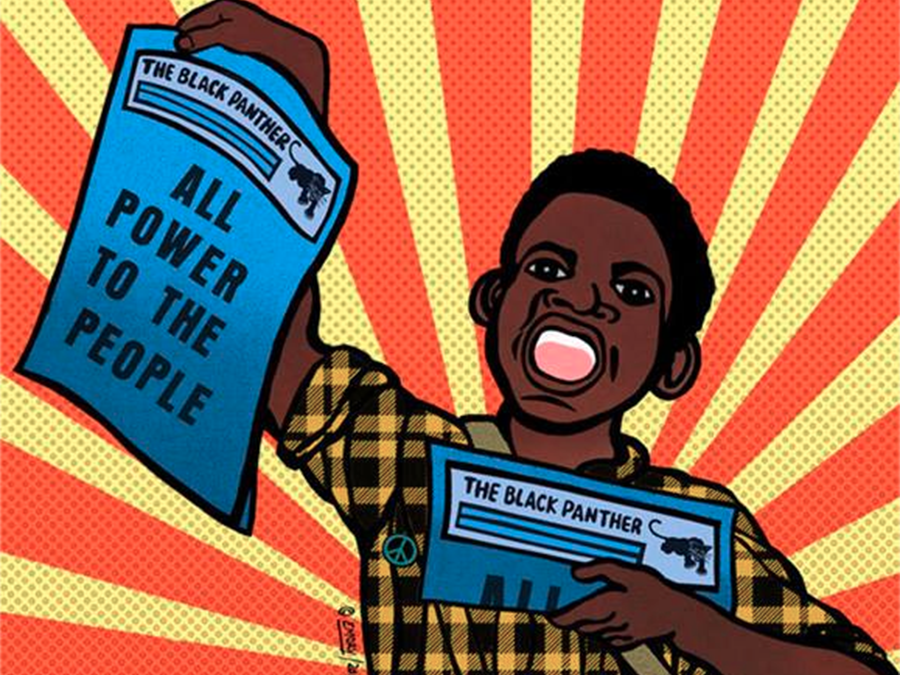All Power to the People by Emory Douglas
Copyright © 2013 Emory Douglas
It’s almost hard to imagine, but principles such as equal opportunity and security for all Americans, now widely accepted, were once considered extreme ideas. And, as history reminds us, making those rights undeniable didn’t come easily.
In fact, changing long-held social norms (and laws) required the dedicated efforts of many courageous individuals, each drawing upon their special talents and inspirations to enlighten and educate and, in some cases, to provoke and agitate.
Artist Emory Douglas was one of those pivotal individuals.
The Art of a Revolutionary
Douglas’s art, which appeared each week in the tabloid-sized newspaper of the Black Panther Party (BPP) in Oakland, California, captured and reflected what writer and activist Greg Jung Morozumi has described as “the inflamed sentiment of the grassroots Black community, who were keenly aware of the racism which kept them disempowered and the mass media that made then voiceless and invisible.”
Coming at the height of social unrest during the late 1960s and early 1970s, Douglas’s evocative images, iconically styled with heavy black lines, graphite shading, and photographic collages and inserts, persuasively presented the African-American community as proud, strong, self-empowered, and self-reliant. Unlike other messages from the Civil Rights Movement, though, Douglas’s work was primarily directed inwards with the aim of mobilizing the community, as opposed to influencing or appealing to outsiders.
A recent exhibition at the Joyce Gordon Gallery in Oakland unequivocally demonstrated that, even 40 years later, Douglas’s work has lost none of its vitality or authority. From the image of a young boy raising The Black Panther newspaper that boldly proclaims “All Power to the People,” to pictures of defiant brothers (and sisters) with rifles and knives in hand, Douglas never flinched from addressing real issues directly.
Douglas’s broad body of work similarly ranges from empathetic representations of the poor, to intentionally inflammatory denouncements of widespread constitutional violations and police abuse of power. Throughout Douglas’s work we see a rich dynamic of the community inspiring art and, in turn, the art inspiring the community.
“The African-American community learned through observation and participation,” explained Douglas. “The art in the newspaper provided understanding and insight into what was going on politically.”
Tracing the Evolution
Born in Grand Rapids, Michigan, Douglas grew up in San Francisco, where he later studied commercial art while attending City College. Becoming aware of the burgeoning Black Arts Movement, Douglas created flyers and announcements for the Black Students Association, including a poster for an event featuring Sister Betty Shabazz (widow of fallen Civil Rights leader Malcolm X). It was during this time that Douglas met Black Panther Party founders Huey Newton and Bobby Seale, who quickly recognized Douglas’s talent and designated him as revolutionary artist for the party’s newly-formed newspaper.
In this role, and shortly thereafter as Minister of Culture for the BPP, Douglas was influential in shaping the public and media perception of the Party, responsible to a large degree in branding the ubiquitous elements including the black berets, leather jackets, and resistant stance. This further included designing the distinctive Black Panther logo which, as Douglas explained, originally came from the Student Nonviolent Coordinating Committee (SNCC), adopted and stylized by Douglas with the SNCC’s blessing.
As you follow the progression of Douglas’s art, you can see the evolving history of the Black Panther Party, with its original focus on empowering armed self-defense and community control of the police. Later, initiatives featuring free school breakfast, along with food and clothing programs for the needy—known as the Survival Programs—dominated.
Participation in electoral politics and community health awareness programs, most notably for sickle cell anemia (which disproportionally affects the African-American community) also became integral to the Party’s mission. “The art was always a reflection of the ideological and philosophical perspectives of the Black Panther Party,” explained Douglas, “that then transcended the Party and offered a universal expression.”
The More Things Change
People familiar with Douglas’s work with the Black Panther Party tend to remember the sensational and the controversial, but all in the context of another time. To paraphrase Colette Gaiter, to many, “this is what the revolution looked like.” However, for Douglas, the journey continues.
Douglas, now 71, remains active, continually producing new work and speaking around the world.
“As much as things change, some things have stayed the same,” explained Douglas at his home studio. “Things have evolved and developed. But, at the same time, you have the same repressive machinery. You still have misinformation, miseducation, lack of employment, profiling, the privatization of prisons, and all of these dynamics.”
“You have growth on one hand,” summarized Douglas, “with exploitation still going on at the same time.”
About Emory Douglas
Visit Emory Douglas on his Facebook page. Prints are available for sale directly from Mr. Douglas.
For more information about Douglas and his art, see Black Panther: The Revolutionary Art of Emory Douglas, edited by Sam Durant.

